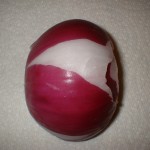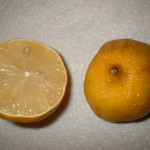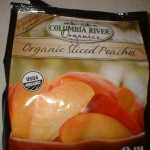By Catharine L. Kaufman — a.k.a. The Kitchen Shrink
Dear Foodies:
There are as many inspired solutions to problems that pop up in the performance of the culinary arts, as there are tricks to every trade. The following 10 food-related tips are just a fraction of discoveries made by women, men and even children who have spent time in the kitchen preparing—not merely re-heating or microwaving—meals.
I bet you have inherited or devised some of your own techniques. If so, we would most appreciate your sharing them with us by email to [email protected], for posting on this site. Please indicate the name to which you wish your contribution to be credited.
(1) Tearless Onions: Putting your onion into the freezer for 5 – 10 minutes before chopping will make the process gentler on your tear ducts. Wearing protective glasses and rapping a cloth around your nose and mouth—bandit style—works, too, if you don’t mind scaring your kids and pets.
Wearing protective glasses and rapping a cloth around your nose and mouth—bandit style—works, too, if you don’t mind scaring your kids and pets.
(2) Salt Overdose? If too much salt spilled into your soup or stew, a pealed raw potato added to the dish will soak up the extra sodium. Just make sure to remove and toss the potato when it’s cooked.
 (3) Lemon Delight: To give baked fowl (chicken, duck, etc.) an extra kick, mix the juice of a lemon with your favorite combination of olive oil, herbs and spices in a bowl, coat the fowl parts well, place them into a well-oiled stainless steel or Pyrex baking pan and pour the rest of the dressing over them. Lemon makes chicken and other fowl more moist and flavorful.
(3) Lemon Delight: To give baked fowl (chicken, duck, etc.) an extra kick, mix the juice of a lemon with your favorite combination of olive oil, herbs and spices in a bowl, coat the fowl parts well, place them into a well-oiled stainless steel or Pyrex baking pan and pour the rest of the dressing over them. Lemon makes chicken and other fowl more moist and flavorful.
(4) It’s a Gas! If you want your freshly bought fruits to ripen quicker, place a variety of them into a paper bag—before washing. Make sure the batch includes a few apples, since the ethylene gasses they emit, hasten the ripening process. This works especially well with semi-ripe avocados.
(5) Color Guard: To keep sliced fresh fruits (especially bananas, apples and pears) or vegetable crudités from becoming discolored by  oxidation, spray them with lemon juice. Raw celery root salad will also maintain its creamy hue when given a quick splash with a milk and lemon mixture right after being sliced or shredded.
oxidation, spray them with lemon juice. Raw celery root salad will also maintain its creamy hue when given a quick splash with a milk and lemon mixture right after being sliced or shredded.
 (6) Fruit For Ice: While whisky and “rocks” go well together, cocktails are best both cold and undiluted by ice—which, whether in cubes or shaved, melts into water. Substitute frozen grapes, berries, peach slices, pomegranate seeds or other fruits for the H2O ice and voilá! you’ll not only have a full-strength cocktail, but one sparkling with colorful fruit garnish—antioxidant- and vitamin-rich bling for the eyes.
(6) Fruit For Ice: While whisky and “rocks” go well together, cocktails are best both cold and undiluted by ice—which, whether in cubes or shaved, melts into water. Substitute frozen grapes, berries, peach slices, pomegranate seeds or other fruits for the H2O ice and voilá! you’ll not only have a full-strength cocktail, but one sparkling with colorful fruit garnish—antioxidant- and vitamin-rich bling for the eyes.
(7) Easy Shelling: When fully cooked, lift hard-boiled eggs and plunge them into ice water to make peeling easy. For best results, remove the eggs before the ice melts completely and place them on a rack, with at least half an inch of space between them for faster cooling.
cooling.
(8) Spear Secrets: Asparagus, when prepared well, is a healthy delicacy fit for discerning palates. So, be gentle and attentive as you cut off the woody end of each spear and, with a veggie peeler, carefully shave any coarser skin you might find on its lower stalk, working upward toward the tip. Its best to leave some stringier skin on, than to remove even a bit of this noble vegetable’s tender part.
(9) Fish Fat: Most fatty, medium and small size fish like salmon, herring and sardines are excellent sources of Omega 3 fatty acids, calcium, protein and other nutrients, while also containing fairly limited (and thus, it is hoped, less dangerous) amounts of merc ury—a toxic metal which is now, unfortunately, found in most marine life. Large fish—such as tuna—on the other hand, accumulate greater amounts of mercury, PCBs and other toxins by eating smaller prey. So here is a tip about reducing the damage: Since toxins tend to accumulate in the fatty tissues found under skin and other parts of the fish, it is best to cut and discard those before cooking, to help reduce exposure. Just remember that this advice is for large fish. Salmon fat and skin, as well as the fat, skin and bones of herring and sardines are where Omega 3,
which is now, unfortunately, found in most marine life. Large fish—such as tuna—on the other hand, accumulate greater amounts of mercury, PCBs and other toxins by eating smaller prey. So here is a tip about reducing the damage: Since toxins tend to accumulate in the fatty tissues found under skin and other parts of the fish, it is best to cut and discard those before cooking, to help reduce exposure. Just remember that this advice is for large fish. Salmon fat and skin, as well as the fat, skin and bones of herring and sardines are where Omega 3,  calcium and other nutrients are concentrated.
calcium and other nutrients are concentrated.
(10) Green Mold: While the yuck factor might tempt you to trash entire chunks of cheeses, let me assure you that it is quite safe to merely shave the moldy parts off—making sure that neither your hand, nor the knife carries even a speck of mold to the clean parts.
(Note: While in the past, my low tolerance for suspicious looking food had me in the habit of discarding nearly full containers of moldy yoghurt, sour cream and such soft cheeses as cottage and ricotta, I have been convinced by Dina, our Editor and super-researcher, that such waste of good food is quite unnecessary. She recommends removing all moldy areas from yoghurt and sour cream—sometimes even a tad more just to make sure what’s left is safe to eat—and cleaning the container thoroughly. When it comes to cottage and other soft cheeses, Dina actually scoops out and discards about a quarter- to a half-inch of the cheese from well below and including the moldy parts. With spoon and a clean napkin, she cleans the sides and lid of the container to prevent re-growth. As to the hard cheeses, Dina advises that, once scraped clean of mold, it should be wrapped tightly with plastic wrap and stored on the coldest—usually lowest—refrigerator shelf. She also marks rescued cheeses and dairy containers with the cleaning date and leaves them front and center on the coldest shelf of her fridge, as a reminder that they should be eaten as soon as possible.)

One Comment on “Food Tips”
Terrific tips. Thanks for sharing. Lots of useful info on your site.